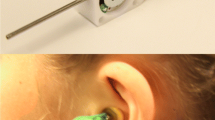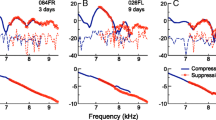Abstract
Otoacoustic emissions (OAE) are influenced in their amplitude and frequency spectra by the middle ear. The effects of changes in the middle ear transmission mechanisms on transiently evoked OAE (TEOAE) and distortion product emissions (DPOAE) were investigated as a function of static ear canal pressure in 25 normal-hearing test persons aged 18–35 years. The ear canal pressure was varied stepwise between positive and negative values of 200 daPa. TEOAE and DPOAE amplitudes were attenuated significantly with changes of the static ear canal pressure, with greatest changes at low frequencies (< 2 kHz). The alterations of OAE amplitude were slightly dependent on the polarity of the pressure, with positive pressure producing a greater attenuation (0.6 dB). The results demonstrate that changes in middle ear impedance can cause a misinterpretation of OAE. To avoid this problem, tympanometry should always precede OAE measurements. Alternatively, both methods can be combined using one acoustic probe, so that the emissions can be evoked at the peak of middle ear compliance.
Similar content being viewed by others
References
Bonfils PA, Uziel A, Pujol R (1988) Screening for auditory dysfunction in infants by evoked otoacoustic emissions. Arch Otolaryngol Head Neck Surg 114:887–890
Brown AM, McDowell B, Forge A (1989) Acoustic distorsion products can be used to monitor the effects of chronic gentamycin treatment. Hear Res 42:143–156
Erwig H, Blömer E, Bauer HH (1991) Zur Evaluation transitorisch evozierter otoakustischer Emissionen bei Kindern mit Tubenbelüftungsstörungen. Laryngol Rhinol Otol 70:635–640
Harris FP, Lonsbury-Martin BL, Stagner BB, Coats AC, Martin GK (1989) Acoustic distortion products in humans: systematic changes in amplitude as a function of f2/f1 ratio. J Acoust Soc Am 85:220–229
Hauser R (1992) Die Wirkung des systematischen Mittelohrdruckänderung auf transitorisch evozierte otoakustische Emissionen — eine Druckkammerstudie. Laryngol Rhinol Otol 71: 632–636
Hauser R, Löhle E, Pedersen P (1989) Zur klinischen Anwendung Click-evozierter otoakustischer Emissionen an der Freiburger HNO-Klinik. Laryngol Rhinol Otol 68:661–666
Hauser R, Probst R, Harris FP (1993) Effects of atmospheric pressure variations on spontaneous, transiently, and distortion product otoacoustic emissions in normal human ears. Hear Res 69:133–145
Johansen H (1948) Relations of audiograms to the impedance formula. Acta Otolaryngol Stockh) [Suppl] 74:65–75
Kemp DT (1978) Stimulated acoustic emissions from within the human auditory system. J Acoust Soc Am 64:1386–1391
Kemp DT (1981) Physiological active cochlear micromechanics — one source of tinnitus. In: Evered D, Lawrenson G (eds) Tinnitus. CIBA Foundation Symposium. Pitman, London, pp 54–81
Kemp DT (1986) Acoustic emission cochleography — practical aspects. Scand Audiol [Suppl] 25:71–82
Kemp DT (1990) A guide to the effective use of otoacoustic emissions. Ear Hear 11:93–105
Kim DO (1986) Active and non-linear cochlear biomechanics and the role of outer-hair-cell subsystem in the mamalian auditory system. Hear Res 22:105–114
Lamprecht A (1991) Evozierte otoakustische Emissionen bei normalhörenden und schwerhörigen Erwachsenen und Kindern. Laryngol Rhinol Otol 70:1–4
Naeve SL, Margolis RM, Levine SC, Fournier EM (1992) Effect of ear-canal air pressure on evoked otoacoustic emissions. J Acoust Soc Am 91:2091–2095
Neely ST, Kim DO (1983) An active cochlear model showing sharp tuning and high sensitivity. Hear Res 9:123–130
Plinkert PK, Kröber S (1991) Früherkennung ciner Cisplatin-Ototoxizität durch evozierte otoakustische Emissionen. Laryngol Rhinol Otol 70:457–462
Plinkert PK, Zenner HP (1992) Sprachverständnis und otoakustische Emissionen durch Vorverarbeitung des Schalls im Innenohr. HNO 40:111–122
Plinkert PK, Sesterhenn G, Arold R, Zenner HP (1990) Evaluation of otoacoustic emissions in high-risk infants by using an easy and rapid objective auditory screening method. Eur Arch Otorhinolaryngol 247:356–360
Probst R (1990) Otoacoustic emissions: an overview. In: Pfaltz CR (ed) New aspects of cochlear mechanics and inner ear pathophysiology. Advances in oto-rhinolaryngology. Karger, Basel, pp 1–91
Schloth E, Zwicker E (1983) Mechanical and acoustical influences on spontaneous otoacoustic emissions. Hear Res 11: 285–293
Wilson JP (1986) Otoacoustic emissions and tinnitus. Scand Audiol [Suppl] 25:109–119
Wilson JP, Sutton GJ (1981) Acoustic correlates of tonal tinnitus. In: Evered D, Lawrenson G (eds) Tinnitus. CIBA Foundation Symposium. Pitman, London, pp 82–107
Zenner HP (1986) Motile responses in outer hair cells. Hear Res 22:83–90
Author information
Authors and Affiliations
Rights and permissions
About this article
Cite this article
Plinkert, P.K., Bootz, F. & Voßieck, T. Influence of static middle ear pressure on transiently evoked otoacoustic emissions and distortion products. Eur Arch Otorhinolaryngol 251, 95–99 (1994). https://doi.org/10.1007/BF00179900
Received:
Accepted:
Issue Date:
DOI: https://doi.org/10.1007/BF00179900




